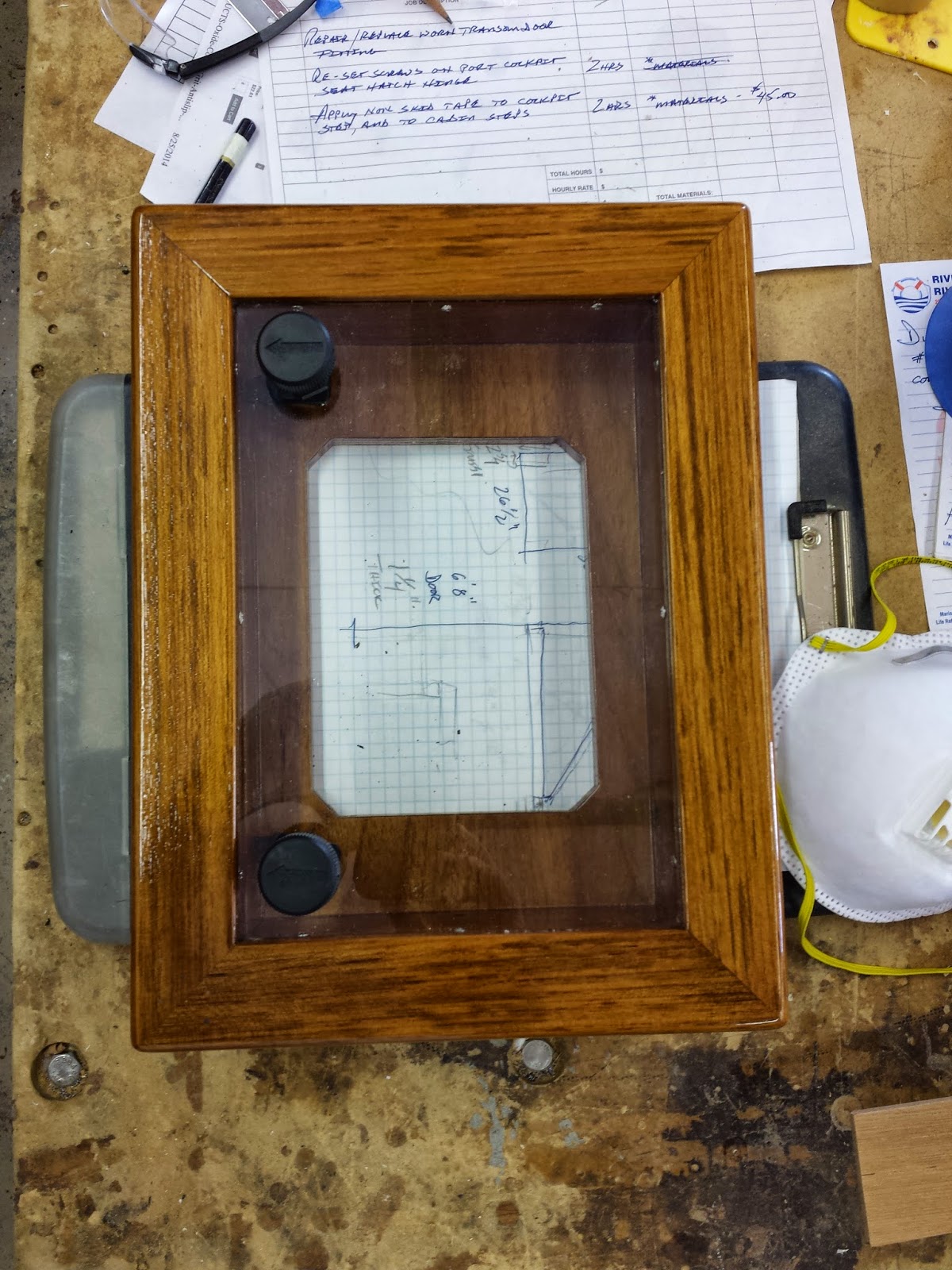A lot has happened since the last update. The mast, boom, and rigging are in place, and plumbing and mechanical work has restarted. We’ve made an interesting discovery about our boat, and have run into a few small roadblocks. Still, we’re moving ahead.
The old backstay chainplate. The tape was placed on the hull to show the length of the spaces between the bolts.
One of the roadblocks came about because of a thin, small,
and very important piece of the rigging system. It’s called the ‘backstay
chainplate.’ As I explained in an earlier post, chainplates are pieces of steel
which are bolted or otherwise mechanically fastened to the hull structure. The
rigging wires, called stays and shrouds, are attached to these chainplates and
hold the mast upright and in place. Because of the age of the existing
chainplates, we replaced them all with new ones as a part of the refit. When I
was ordering the new ones from the builder, Thumper Brooks, (yes, that’s his
real name!) the operations manager for Pacific Seacraft advised me that around
the time Jo Beth was built, the mounting configuration for the backstay
chainplate had changed slightly. I took careful measurements of the existing
backstay chainplate and forwarded them to Thumper.
So, you can guess what happened when the time came to
install the chainplate – the configuration, with regard to where the bolt holes
were cut in the chainplate and in the hull – were slightly off. Thumper had said the chances of getting an exact fit were going to be slim. The fit wasn't too far off, about 1/16 of an inch. The problems
were easily addressed; a new backing plate, to match the correct configuration
of the bolt mounting holes, has been made and the plate fitted. The mast was
stepped and the rigging fitted. The boom has been installed, the halyards
(lines which raise and lower sails) and mainsheet, (the line which controls the
mainsail), have been run. Rigger Greg Johnson will be installing other small but
important accessories on the mast and boom during the next week or
two.
Hoisting the new mast to be stepped aboard Jo Beth
Hinckley riggers Greg Johnson and Mark Edwards guiding the new mast on to Jo Beth
Jo Beth with her new mast and boom
The new mainsheet assembly
The final steps to convert the quarter berth to a useable
storage locker are underway. Aboard Jo Beth, there is a single large storage
locker in the cockpit on the port side of the boat. The starboard side had a
storage locker as well, but it was fitted with a shallow pan, perhaps 6 or 8 inches deep, in which we stored spare power cords, line, etc. Beneath the pan
is a quarterberth, a supposed sleeping area in the cabin. In reality, a
quarterberth is a dead space on the boat, not useful for sleeping or storage. (I described a quarterberth in this post.) We
decided to remove the pan in the starboard locker, build a bulkhead in the
cabin, and make the quarterberth a useful space. The pan is cut and the conversion
well underway.
The locker pan is cut, opening the quarterberth space into a storage locker
However, with the removal of the locker pan, we’ve discovered another
issue. On the inside of the edge of the locker where the pan was attached, the
fiberglass structure had only partially bonded to the deck structure. This is
something that apparently occurred during the construction of the vessel. It’s
not a serious issue by any stretch of the imagination, but it needs to be
repaired. And so, repaired it shall be – another unplanned line item to the
budget.
This is the area of non-bonded structure found in the starboard
cockpit locker; it can also be seen in the photograph of the water
heater, below
The new water heater, fitted in the new cockpit locker
The new lifelines, wire cables strung between stainless
steel stanchion posts which provide security for persons on deck, are fitted and
small repairs made to the boarding gates and bow railings. We’re also ordering
a stainless steel folding boarding ladder which will fit inside one of the
boarding gates and allow us to get on the boat from the water or dinghy. The
ladder will work on either side of the boat.
Repairs to the portside boarding gate; also, the new chainplates can be seen also
Here's a test fit of the new insert made for one of the two overhead deck hatches aboard Jo Beth; finish work on the hatch inserts and battens remain to be done
The new engine control panel box and cover
Now, we’re at the stage where plumbing and mechanical
projects are underway and heading towards completion. The new canvases for the
boat exterior and interior cushions are being made. The new engine control panel box and cover, now watertight, is installed. The overhead is nearly completed. The refit is getting to the
point where, with some degree of confidence, we can start to anticipate a
completion date. Even so, much work will remain, even once Jo Beth is afloat again, but the
day when we can once again sail her into the wide waters of the Atlantic are in
sight.




























